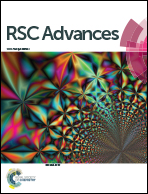Biomass derived xylose Guerbet surfactants: thermotropic and lyotropic properties from small-angle X-ray scattering†
Abstract
A series of novel branched-chain glycosides were synthesised from xylose, an aldopentose and Guerbet alcohols whose total number of carbon atoms ranges from C8–C24. The thermotropic and lyotropic phases of the highly pure Guerbet xylosides were investigated, using differential scanning calorimetry, optical polarising microscopy and small-angle X-ray scattering. In dry conditions, the shortest compound (total C8) exhibits a monotropic lamellar (Lα) phase while the C12 compound forms a rectangular columnar (Colr) phase at room temperature, a rarely reported phase in lipidic systems. The longer ones (C16, C20 and C24) adopt inverse hexagonal (HII) phases. Upon hydration, the Lα phase of the C8 compound remains, and while that of the C12 compound exhibits an inverse bicontinuous cubic phase of space group Ia3d in excess water. The C16 and C20 compounds remain in the HII phase upon hydrating, but the lattice parameters for the hydrated forms increase considerably. An inverse micellar Fd3m cubic phase is observed in the fully hydrated C24 compound. The amphiphilic nature of these compounds coupled with the ability to form inverse non-lamellar phases at room temperature makes them ideal candidates for a variety of applications such as controlled release drug-carriers.


 Please wait while we load your content...
Please wait while we load your content...